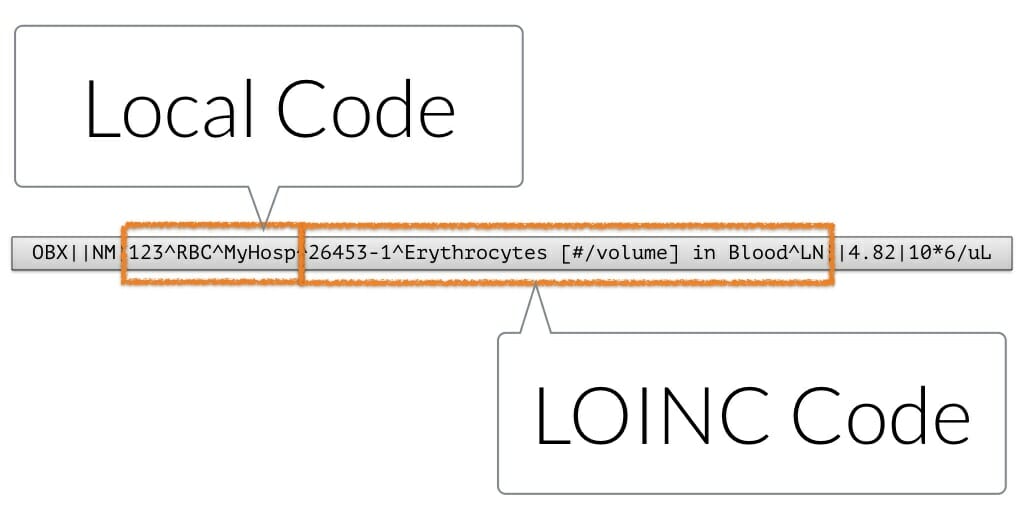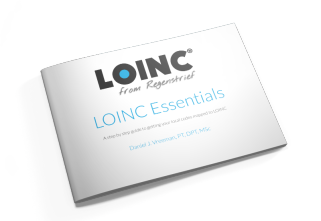In addition to the FSN, LOINC publishes two addition names for each LOINC term: a Long Common Name, and a Short Name. With three different names to choose from, I’m often asked which LOINC name should I use?

Julius Winfield Erving II. The Doctor. Dr. J.
Just like Julius Erving the basketball great, a LOINC term might be referenced by different names for different purposes.
We define a LOINC term as a representation of a question about a clinical phenomenon that can be observed or measured (e.g. “serum sodium concentration”, “measured body height”). A LOINC term has a code (i.e. the LOINC code) and associated names. LOINC codes are for computers. LOINC names are for humans.
Let’s briefly review the official LOINC names.
Official LOINC Name Types
Each of the LOINC name variants provide a human-readable text rendering of its associated LOINC Code. To illustrate, let’s use the common serum blood urea nitrogen (BUN) test as an example.
Fully-Specified Name (FSN)
Urea nitrogen:MCnc:Pt:Ser/Plas:Qn:
The FSN (also known as the Formal Name) is the combined five or six part name of a LOINC term. Its parts include:
- the name of the component or analyte measured (e.g., glucose, propranolol)
- the property observed (e.g., substance concentration, mass, volume)
- the timing of the measurement (e.g., is it over time or momentary)
- the type of sample (e.g., urine, serum)
- the scale of measurement (e.g., qualitative vs. quantitative), and where relevant
- the method of the measurement (e.g., radioimmunoassay, immune blot)
The FSN typically uses official, scientific names for things in the Component but abbreviations for the Property and System (see the LOINC User Manual). As a result, some FSNs look pretty foreign to clinicians. (See INR, for example).
Long Common Name (LCN)
Urea nitrogen [Mass/volume] in Serum or Plasma
The LCN is designed to be a more fully spelled out and human readable name for a LOINC term. It uses common names for things like allergens in the Component, transforms the cryptic Property abbreviations like MCnc into more understandable phrases like Mass/volume, and drops the default timing of Pt.
Short Name
BUN SerPl-mCnc
Many older laboratory information systems had tiny field limits for test names. LOINC creates Short Names with a target limit of 40 characters to fit some of those constraints. They can also be handy for column headers on reports, etc where you want a compact label. For some tests, especially those with multiple components, it’s simply impossible to produce meaningful name with this constraint. Nevertheless, we try. In contrast to the FSN, case matters in the Short Name. The Short Name makes extensive use of acronyms and abbreviations. It also contains common names rather that formal Latin species names, etc.
There are a couple of important caveats to keep in mind about the Short Name. First of all, not all LOINC terms have them, so they can’t be used as identifying keys in any database. Across all of LOINC, about 8,000 terms do not have a Short Name. Most of these are survey instrument terms. All of the lab terms do have them. While we aim make them unique, there are quite a few duplicates. The vast majority of duplicates are for pairs of terms that differ only by having a Scale of Nar vs Nom.
Which LOINC name to use for what
While mapping to LOINC, you should focus primarily on the FSN. But, after you’ve mapped your local variables to LOINC, there are at least four main uses cases where you might ask yourself which LOINC name to use.
What to show clinicians (front end)
Lab tests
If you are displaying lab tests results to clinicians on a report (such as a flowsheet or results viewer), your best bet is probably to use a locally crafted name (e.g. the lab’s test name). Most of the implementations around the world using LOINC have a local “interface name” that users see. LOINC is working in the background.
Why use local names? Well, clinicians are already familiar with them. You can curate abbreviations and conventions to your context. And LOINC names have some unusual features (e.g. Property) that are foreign to most clinicians. It’s not that you can’t use LOINC terms for this purpose, it’s just that most people don’t. They might be perfectly fine for research applications, but less desirable in clinical care systems.
In your context, you may be able to make certain assumptions and thereby omit key aspects of the LOINC name from your name. For example, if the reporting units of measure are always displayed right next to the test result, then it might make sense to omit the Property for your display name. Across the whole database, LOINC would have tons of duplicates if the Short Name omitted property. But in most local contexts there aren’t that many variations.
Other clinical variables and document titles
Here too, local names probably still prevail. But, for uniform document titles, I think the LCN is very usable. For example “Discharge summary” or “Physical therapy Progress note” are nice labels.
Patient assessment instruments like surveys, standardized forms, etc. present a little bit of a special case. Since LOINC models these terms in a way that faithfully preserves the original form context, you can easily render the original display text. For more information, see the Choosing the “display text” for a question or variable in the LOINC Users’ Guide section on Standardized Assessment Measures.
What to put in the EHR (backend)
Behind the scenes, software applications that use LOINC are required to follow the LOINC License. Section 9 of the LOINC License requires that systems include the 6 fields that comprise the FSN as well as the Short Name, and strongly recommends also including the LCN. How systems choose to make use of these fields is up to them, but they are required to be there.
In general, I would recommend the LCN as the primary name for a LOINC code in any information system data dictionary.
If your EHR has a table of observations for patient data where LOINC codes and names are stored, I’d recommend using the LCN there. Some systems just have codes in that table, and then look-up information about the observation from a separate a “data dictionary” table. See for example, the OpenMRS Data Model. In any such data dictionary, I would also use these LCN as the primary display name for the LOINC term. As required by the LOINC License, linking the LOINC code to the six fields of the FSN in the system makes it possible to query and group results in all sorts of interesting and useful ways.
What to put in the exchange (message, document, or resource)
When exchanging clinical data, most standard formats (e.g. HL7 version 2 messages, CDA, FHIR) have structures to send both local codes/names and standard codes/names. It is always recommended to send both the local code and its name along with the LOINC code and its name. Sending both local and standard codes allows for validation, debugging, and conformance with regulations (like CLIA) that may require performing laboratories to transmit their test name.
This works the same whether you are using an HL7 version 2 ORU message, a C-CDA, or FHIR observation resource. Here’s an example of how it works with an HL7 version 2 message.

So which LOINC name should you send along with the LOINC code in the exchange?
The LOINC License says that when the LOINC code is included in the message, users are encouraged, but not required, to include the corresponding LCN or Short Name.
In general, the LCN is the recommended name for use in these contexts.
The LOINC LCNs are probably the most understandable to human readers. They also contain fewer instances of reserved instances of ‘reserved characters’ like “^” and “&”, which would need to be escaped in the message syntax. Properly escaping these characters is technically quite simple, but many systems don’t do it.
There are some situations where sending or receiving systems cannot accommodate the LCN because of character limits. In these cases the Short Name is an acceptable alternative. Sending the FSN (e.g. a colon-separated aggregate of the six part name) is generally not recommended.
To be clear, use a LOINC name with a LOINC code
Historically, there have been problems with people sending a LOINC code with their own test name where the LOINC name is supposed to go. Or, instead of using one of the three official LOINC names, they would send only the Component.
Both of these practices go against the recommendations from LOINC and from HL7. For reference, see the LOINC Users’ Guide, the LOINC License, and HL7 proposed guidance on use of displayName(V3 CD) and Text (V2.x CNE,CWE).
The best practice is to use a LOINC name with a LOINC code, and use your local name with your local code (if you have one).
What to put in a technical specification (e.g. an implementation guide or other standard)
If you are writing a technical specification like an HL7 implementation guide, and IHE profile, or listing LOINC codes in any similar document like a package insert or other reference material (including webpages), the LOINC license requires you to include one of the official LOINC names. (See Section 10 of the license for more information).
It’s up to you whether that is the FSN, the LCN, or the Short Name. In almost all cases, the LCN is the best and recommended choice.
The main point is that if you are including LOINC codes in your document, you need to also include one of the official LOINC names.
A word about LOINC Answer Codes
In addition to codes for observations, LOINC also creates some codes to identify qualitative or nominal result values (a.k.a. Answers). These individual answers are assigned a non-semantic identifier with a “LA” prefix and a mod-10 check digit. The answer codes LOINC assigns are unique by lexical string (ignoring capitalization), and by intention are not maintained as true “concept” oriented terms. The same principle as above applies to LOINC Answer Codes:
If you are including a LOINC Answer Code in your document or message, you need to include the corresponding LOINC Answer name (DisplayText).
Just like with observation codes, it is highly recommended that you also send any local code and local name along with the LOINC Answer Code.
Learn LOINC Fast
Get the secret weapon that will jumpstart your LOINC mapping and make you a LOINCer extraordinaire in no time
$4.99
Acknowledgments
This material contains content from LOINC® (http://loinc.org). The LOINC table, LOINC codes, and LOINC panels and forms file are copyright © 1995-2017, Regenstrief Institute, Inc. and the Logical Observation Identifiers Names and Codes (LOINC) Committee and available at no cost under the license at http://loinc.org/terms-of-use.

